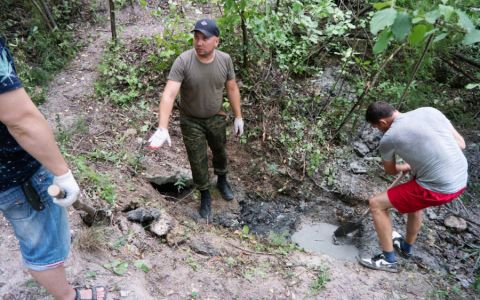Fish are indicators of contamination of rivers by toxic chemicals. It is logical with respect to life of the fish as they are on the top of food pyramid, or of food chain, in water ecosystems. Accumulation of toxics in the fish often give an answer to heath problems of people who consume them or who just live near large chemical plants.
Mercury had been used in the production of chlorine in Japan in the 1950sand released to Minamata Bay without any restrictions. The mercury penetrated bodies of the fish consumed by local inhabitants who then suffered from various dysfunctions and even from brain paralysis or mental retardation in case of newborns. This case can be also illustrated by a story of a cat fed by remains of the fish form the same bay who lost control over her nervous system. The cat reportedly walked across a table and fell off as she could not estimated its length because of the damage to her nervous system.
Toxic chemicals have been observed due to their presence in the fish tissue in the Czech Republic as well. Results of the fish monitoring was recently summarized in the „Report about a State of Water Protection in the Czech Republic in 2003“ in following words:
„It must be considered during observation of pollutants in fish that the fish migrate and their state does not correspond only with concrete concentration of the pollutant in the location where they were caught and it also depends significantly on the age of fish that was caught.
Measured concentrations of cadmium and lead were usually under the level which can be determined. Mercury concentrations were between 0,2 and 12,3 mg.kg-1 with the highest concentration in Elbe-Obříství (12,3 mg.kg-1 in a chub in 2002), Lysá nad Labem and Děčín and in Vltava – Zelčín. Concentrations of arsenic were in a range from 0,5 to 1,6 mg.kg-1 with the highest levels in Elbe-Obříství and in Vltava-Zelčín. Chlorinated pesticides for isomer p,p DDT were in a range from 1 to 57 μg.kg-1 with the highest levels in Elbe - Obříství, Bílina – Ústí nad Labem and in Dyje – Pohansko. The highest levels for isomer p,p DDE were fond in Dyje – Pohansko, Bílina – Ústí nad Labem and in Elbe – Obříství (22 to 890 μg.kg-1). As for polychlorinated biphenyls, the highest concentrations were measured in profiles Vltava-Zelčín, Dyje – Pohansko, and in Elbe- Děčín (82 to 563 μg.kg-1). The highest level for the sum of indicator congeners PCB was registered in Elbe- Obříství in 2002 (2 117 μg.kg-1) but in previous two years the concentrations achieved 144 and 470 μg.kg-1.“
Fish is first of all a good indicator of burden represented by toxics which persist in environment for a long time and accumulate in animal fat – so called persistent organic pollutants – POPs – substances such as pesticides DDT and polychlorinated biphenyls which can harm human immune and hormonal systems. Group of nine pesticides, polychlorinated biphenyls and dioxins thus became object of international Stockholm Convention which came into force by 17 May 2004. The convention bans pesticides and polychlorinated pesticides and it should also lead to a minimalisation of dioxins´ occurrence. In the future it can be completed with other substances if they would be proved as dangerous for health and environment and that they have the ability to accumulate in the environment. Polybrominated diphenylethers also belong to the POPs.
Polybrominated diphenylethers (PBDE) are used as flame retardants for instance in consumer electronics including computers, carpets and polyurethane foams in furniture. According to numerous studies, PBDE accumulate in animal fats similarly as polychlorinated biphenyls and in tissues of animals – it was discovered that for instance tissues of falcons in Sweden contained the same high concentrations as those which caused nerve damages in laboratory rats. We ordered measurement of concentrations of PBDE in 3 fish samples taken in different rivers in order to find at least approximate levels of these chemicals in various locations in the Czech Republic. The observed fish species were barbell caught in November 2003 in river Odra near Ostrava, trout caught in the beginning of 2004 in stream by Lampertice (under the outflow from the former mine Jan Šverma which now stores hazardous waste) and a perch caught in Elbe in Poděbrady.
Analysis of content of PBDE was ordered in the University of Chemical Technology in Prague. PBDE was found in all the caught fish. Comparison of concentrations in each type of fish can be shown in graphs. Graph 1 shows how much PBDE a person would consume when eating one fish. For a comparison, the graph 1 also shows a level of PBDE in a trout caught in Králíky as measured by the University of Chemical Technology itself. Graph 2 shows levels of PBDE per gram in fish fat and it is more suitable for comparison of burden in the localities. However, such comparison is not simple as it must be considered that different species of fish were observed and that we could order analysis of just one fish from each locality due to our limited financial possibilities. It means that the results serve only as an orientation or illustration of what the environmental burden is like. In this comparison, Elbe near Poděbrady comes out as the worst point, but, as I emphasized, the survey has just an indicative value.
The substantial fact for us is the fact that the PBDE are present in Czech environment and it would be favorable if the institutions and authorities of environmental inspection paid increased attention to these toxics. Some of the US states and some Scandinavians states have already limited or stopped the use of PBDE. ARNIKA´s petition „Toxic Free Future – II.“ demands the same. Requirements listed in the petition are directed towards general reduction of presence of the toxics in environment, it means also in particular in fish.






